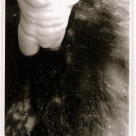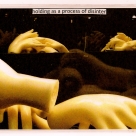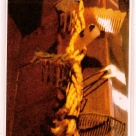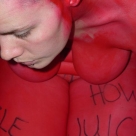Blood Dance and Cell Poems
This project is effort to engage a new originality–one wherein the physical and ethereal converge and collate elliptically. Perhaps a site where we can all be native to something. cell-poems are a path to that nativity--are organelles engaging verge in order to expand the physicality of potentials. In the cell-poems, ethereal image and rhythmic text admix to generate a trance state--visceral textures and identities of ulteriority. All of this for generative, venerate abraxas.
Perhaps we need an ongoing argument to move the ethereal entirely to its end. This eternal visceral performance, a way to continue to understand the ethereal as a kismet—as purported endlessness.
Or, what would we be performing if we were no longer performing exterior pedagogies? We would be inarguable authenticities.
If there is to be a span that is truly endless--capable of holding all elements within it as it exists (it its own elemental), it could be, in my opinion, only by way of the ethereal (ethereal not as any binary opposite to physical, but as a mass that itself has space for all fractures, fractals, fissures, quakes, quasars, slips, sonorous wakings, etc.).
I am saying, oh the empowerment in freeing ourselves from what it is that in matter’s socialized “laws,” is perceived as keeping us here. How freeing, because to choose to stay, once we have really transcended what needs to be transcended (in order to experience this freedom)--to inhabit this plane, our bodies, with a most pristine and precise purpose, is to no longer have to be victim or villain or an opposite to________. To emancipate what we are, beyond strictures and systems that did not inherently come from us (systems that do not support us on the level of our cosmic originality) is an extremely contemporary emancipation. One that I feel is sorely needed.
If only so that we can be engaged in “a process of transcendence of the binary, the oppositional, the historically reified object state. For this new fluidity, slippage, a constant movement revels/reveals the multiplicities folded within all experience and possibility…the many and the one” (per a conversation with Marthe Reed about my performance work). If only to generate an elliptical-sacrosanct, a type of ritual that can be engaged as non-linear method by which the body comes into its variable awarenesses. By activisms of alertness (for the sake of force-effecting consciousness) this type of ritual could allow for empowerment concerning generating, then grouping, new logics.
Marthe Reed asked me the following beautiful question which I found to be a pertinent part of this essay/exploration: “How does one transcend the ethereal and inherit the body?”
I do not think that there is even a necessary transcendence of the ethereal that would lead to inheritance of the body. In fact, I believe the human body—the literal physiology/presence of the body (both bound neutrons and free neutrons moving within and in and out of the physicality of our forms) prove the body to be living/physicalized ether. By this I mean living potential, infinitely capable of shape shifting—of being shifted. An active shrine activating our bodies as ongoing documents of the very infinity that if we live to connect with and pursue, is already itself-infinitum.
Non-stable elements of physiology move in and out of what has been explained by some theorists as “a veil” between physical form and ethereal span. I am proposing that the body can be made more non-stable (infinitum) due to our volition and that in that gesture, the body can be felt, as infinitum to us. I am saying it is possible to inhabit the body as ethereal matter, by choice and awareness. I am saying that the fact that we are in our bodies, inhabiting them by choice, makes these bodies inherently ours.
“I feel extremely at ease when my inner self is not recognized even by myself.” (Tatsumi Hijikata)
As the great Sadhus of India have proven (Sadhus are sanyasi, or renunciates who have left behind all substance/material attachments and live in caves or forests or temples—“some live in the mountains alone for years at a time, eating only a few bananas, while others walk around with one hand in the air for decades. Some live in cemeteries and claim to keep company with ghosts, still others partake in the religious consumption of charas and contemplate the cosmic nature and presence of God.” [] “It is thought that the austere practices of the Sadhus help to burn off their karma”), the more we inhabit (rather than inherit, which implies that there is something to be inheriting the body from—that the body/form is not inherently ours) the body as ethereal matter, the smaller the chasm (experienced as a gap or as veil or? Between the physical and ethereal) becomes.
“The human body transforms itself endlessly.” (Tatsumi Hijikata)
A couple of years ago I performed a short run of blood dances that I feel accurately reflects the intentions of this essay. Painted entirely red by hand (my own hand) prior to going on stage. Certain dark scripts etched into my body. (I am remembering now the way that the ink stayed, stained my skin for months afterward. My shower is still red with remnants of the paint which was not body paint and therefore (intentionally) was a sort of permanence)—oh the expressed span as the quietudes became energetic and dynamic spurts! Grief let by singing. Self-induced, animated inhabitation of the body as activism. I tied and bound myself to the point of only being able to hobble out from the room (where I prepared) to the stage where I performed. Covered in a thick monk’s cloak, shaking and sounding inverted versions of the spirituals that were delivered to me via relationships to people who died as “slaves.” Oh the complex combination, all of the parts somehow meaning a whole of my body.
The inebriated conglomerate smearing.
“What is my work? Yes, it’s myself” and “I’ve nothing to show you but my own body.” (Tatsumi Hijikata)
And the guillotine (as is mentioned in what I “named” the piece) in my mind, was the audience. The bareness of my dick flouncing out as I slowly unbound myself (this was incredibly hard to do, as I tied the knots tight, as if holding another captive). Cloak first, then rope. The tears and sweat that ran down my body conveying a vulnerable yet inherent divergent red. The tears that I shed during as a form of self-birthing. Not a metaphor. I literally built a canal that shred me by way of necessary violences. I performed the shredding in front of other people of whom I could not guarantee any efficacy (concerning gender/sex support) or awareness in the context of equity in regard to divergent bodies. Sometimes they laughed. Sometimes there was silence. Sometimes weeping form the audience. But always this vertigo for me.
“The gorgeously wrought ceremony of inbounding one’s self from violences speaks so intimately to the way violence nests in our systems, is internalized and becomes us. The skin has to tear at itself to be released.” (Brenda Iijima, from a conversation about the performance).
A violent visitation between planar realities without ever leaving the body. Layers and layering are what make passage possible. That there could be such passage, meant for me, that my body was ephemeral data that I was capable of feeling physically and ephemerally.
“It was when he came up to Tokyo for the first time that he tried to mimic the way a condemned criminal is supposed to be walking in a prison yard. He is not walking with his legs upright but with his legs collapsed by despair. Therefore we will fail to grasp the reality of the human body if we don’t think that sometimes we have to walk with our collapsed legs. You know if you put some water on burning ashes, an ash column will rise instantaneously for a few seconds. That’s the way we are forced to walk. This discovery led him to the principle of his Butoh dancing.” (Kayo Mikami on Tatsumi Kijikata’s Butoh dance).
Expressing by way of unusual rawness. The gruesome muses inverting misery by way of mystery’s cresting with such graphic crèches.
(thank you Sous Les Paves for running a previous version of this piece)
j/j hastain is the author of several cross-genre books including the trans-genre book libertine monk (Scrambler Press), anti-memoir a vigorous (Black Coffee Press/ Eight Ball Press) and the xyr trilogy (a metaphysical romance). j/j’s writing has most recently appeared in Caketrain, Trickhouse, Housefire, Bombay Gin and Aufgabe. j/j has been a guest lecturer at University of Colorado and Naropa University.





